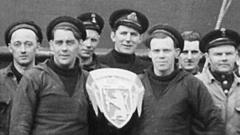The 'Shetland Bus' was a covert operation during WWII that involved perilous journeys across the North Sea to assist Norway's resistance against Nazi forces. As we honor its legacy, six historic vessels will retrace their routes, signifying the enduring bond between the Shetland Islands and Norway.
Remembering the Shetland Bus: A Vital Operation in Norway's Resistance Against Nazi Occupation

Remembering the Shetland Bus: A Vital Operation in Norway's Resistance Against Nazi Occupation
As the 80th Anniversary of VE Day approaches, the Shetland Bus legacy is set to be commemorated with a nostalgic voyage, harking back to the crucial operations that aided Norway during World War II.
The Shetland Bus operation may sound like the premise of a thrilling novel, but it played a crucial role in helping Norway's resistance during Nazi occupation in World War II. Under the shroud of winter's darkness, small fishing vessels departed from Scotland's Shetland Islands, delivering essential supplies and intelligence agents to the Norwegian coastline, while also providing refuge to those fleeing the oppressive regime.
To mark the 80th Anniversary of Victory in Europe (VE) Day, six ships connected to the Shetland Bus will embark on a commemorative journey from Bergen, Norway, back to Shetland, arriving in Lerwick just in time for the VE Day events.
The backdrop for these operations was set on April 8, 1940, when Nazi Germany invaded Norway, forcing the Norwegian government and royal family into exile in London. Thousands of Norwegians also sought refuge across the North Sea, utilizing fishing boats to escape the looming threat. In response, British Prime Minister Winston Churchill established the Special Operations Executive (SOE), aimed at conducting espionage and sabotage throughout German-occupied territories.
Between 1940 and 1945, the Shetland Bus convoys executed 200 dangerous crossings, effectively transporting resistance agents, weapons, and supplies, while rescuing over 300 Norwegian refugees from Nazi tyranny. The covert operations, often executed in the harsh conditions of winter, were fraught with danger, as German patrols posed a constant threat to the small vessels.
One of the remarkable missions involved the fishing boat M/K Arnefjord, which valiantly carried 20 refugees from Norway during treacherous weather in September 1941. Even with adverse conditions, the crew persevered, emphasizing the resilience and bravery that characterized this initiative. Unfortunately, the operation was not without its cost, with ten boats lost and 44 lives sacrificed in service to the cause.
Morten Neset, the current captain of the M/K Arnefjord, emphasized the importance of conducting these crossings under the cover of night, stating, "If they crossed on a clear summer day, they would be spotted straight away." The Shetland Bus provided a beacon of hope, showcasing the solidarity of those standing against occupation.
Bill Moore from the Shetland Bus Friendship Society remarked on the significant impact of the operation, stating that it fostered optimism among Norwegians, as they often referred to their escape as "taking the Shetland Bus."
Throughout the war, connections were forged between the people of Shetland and Norway, as residents hosted soldiers and refugees, nurturing a friendship that persists to this day.
The Liberation Convoy is set to depart from Bergen at 19:00 on Sunday evening, with plans to arrive in Lerwick by morning on Tuesday, May 6, coinciding with a series of VE Day celebrations aimed at honoring the resilience and sacrifices of those involved in the Shetland Bus operation.




















